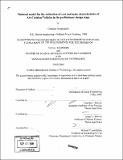MathCAD model for the estimation of cost and main characteristics of air-cushion vehicles in the preliminary design stage
Author(s)
Gougoulidis, Georgios
DownloadFull printable version (11.52Mb)
Other Contributors
Massachusetts Institute of Technology. Dept. of Ocean Engineering.
Advisor
Timothy J. McCoy and Henry S. Marcus.
Terms of use
Metadata
Show full item recordAbstract
In the naval architecture terminology, the term ACV (Air Cushion Vehicle) refers to this category of vehicles, in which a significant portion of the weight (or all the weight) is supported by forces arising from air pressures developed around the craft, as a result of which they hover in close proximity to the sea. Major types are hovercrafts and SES (Surface Effect Ships). A well-designed Air Cushion Vehicle (ACV) is superior to a conventional ship, because it has less drag and requires less horsepower to operate at the same speed. An ACV is much more fuel-efficient than a ship with similar capacity or size. Rising fuel prices and shortages will make ACVs a desirable form of transportation in the future. In order to cover this future trend in marine transportation, a MathCAD model for the estimation of the main characteristics of Air Cushion Vehicles in the preliminary design stage is being developed. This model is based on a statistical analysis of the various parameters of existing crafts. For this reason, a statistical database has been created using publicly available information. A regression analysis has been performed using the data collected and the trend lines for every case have been derived. (cont.) For the validation of the code, LCAC (Landing Craft Air Cushion) is used as the reference vehicle. The values of LCAC design parameters that are known, are input in the code and crosschecked with the outputs. Iterative procedures have been applied to the code in order to correct the trend lines according to the reference model. The development of this MathCAD model is directly related to the lack of software dealing with the design of ACVs in the market. Conventional ship design tools are widespread and used even by students. On the other hand, ACV design programs are possessed by the companies that design this kind of crafts and are not widely available. In the following pages, together with the analysis of the model developed, the associated theory is presented so that the reader has a complete image of what an ACV is and how it works. Hence, this thesis is not a manual of a program, but a combination of theory and application intended to help the reader-user understand the design process of ACVs.
Description
Thesis (Nav. E. and S.M.)--Massachusetts Institute of Technology, Dept. of Ocean Engineering, 2005. Includes bibliographical references (p. 66-67).
Date issued
2005Department
Massachusetts Institute of Technology. Department of Ocean EngineeringPublisher
Massachusetts Institute of Technology
Keywords
Ocean Engineering.